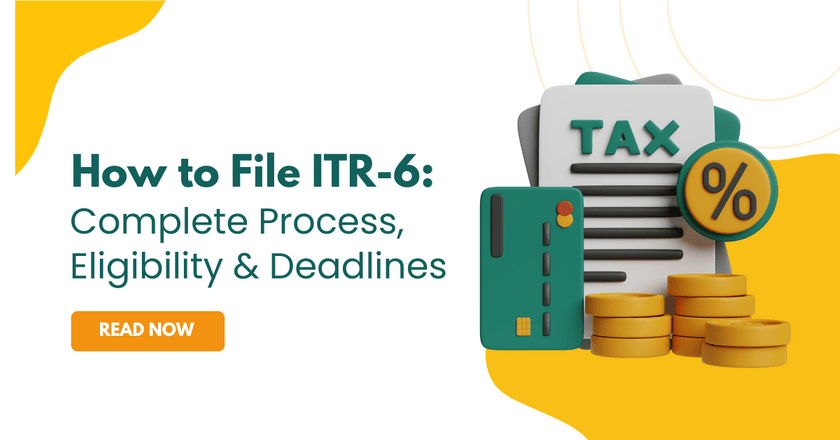If you run a company in India, then filing the ITR-6 form is necessary as per the government rules. So, does ITR filing stress you out every year? If yes, then this not only happens with you, but it’s a story of almost every business.
Filing ITR might seem complicated, but it’s actually not that scary once you understand the basics, and if you have a filing guide. Thus, to make this easier for you, we have created this blog on how to file ITR-6.
This blog covers every step in detail and adds-ons like what you need to file this type of ITR form, what the ITR-6 due date and more.
Let’s first discuss what ITR-6 is in short. For a detailed description of ITR-6, you can check out our other blog.
What is ITR-6?
ITR-6 is the Income Tax Return that needs to be filed by companies that are defined under Section 2(17) of the Income Tax Act. It is for domestic companies, companies operating outside India, or any other institution that is treated as a company under this act.
However, the companies that claim exemptions under Section 11 of the Income Tax Act have to file ITR-7, and they cannot use the ITR-6 form.
To put it simply, if you have a company and you earn from a business or a profession and are not exempt u/s 11, you have to file ITR-6.
Now, before moving on to the steps on how to file ITR-6, let’s know about the structure of the ITR-6 form.
Structure of the ITR-6 Form
The form is detailed and divided into two parts and multiple schedules.
Part A – General information, Balance Sheet, Manufacturing Account, Trading Account, Profit & Loss Account, Other Information, Quantitative Details, and company under liquidation details.
Part B – Computation of total income and tax liability.
Additionally, there are 46 schedules, covering:
- Income sources like House Property, Business/Profession, Capital Gains, Other Sources
- Depreciation, Deductions (Sections 80G, 80IA, 80IB, 80IAC, 80LA, etc.)
- Income from Virtual Digital Assets (VDA)
- MAT (Minimum Alternate Tax) and MAT credit
- GST turnover details
- Foreign assets and income from abroad
- Shareholding of companies, start-ups, and unlisted companies
- Assets & liabilities statement
Documents Required for Filing ITR-6
Before you start filing ITR-6, gather all the documents mentioned below:
- Company PAN and TAN
- Audited financial statements such as Balance Sheet, Profit & Loss Account, Manufacturing/Trading Account (if applicable)
- Form 26AS – Tax Credit Statement
- TDS and TCS certificates
- Details of advance tax and self-assessment tax payments
- Audit reports (Form 3CA-3CD / 3CB-3CD) if applicable under Section 44AB
- Details of foreign assets/income (if applicable)
- Investment and donation details for claiming deductions under Sections 80G, 80IA, 80IB, etc.
- Additional Assets & Liabilities form if total income exceeds ₹50 lakh
Having all documents ready will help you in filling out the form without errors or delays.
So, filing of ITR-6 can be done through the official government portal or any income tax software (to make a few steps automated). It depends on a company’s personal choice. We have explained the steps on how to file ITR-6 through the official Income Tax Portal.
How to File ITR-6: Step-by-Step Process
The Income Tax Department mandates electronic filing with a digital signature for ITR-6.
Here’s the complete process explained:
Step 1: Visit the official Income Tax website – www.incometax.gov.in. Sign in using your credentials – PAN as user ID and respective password.
Step 2: The Dashboard will appear. Go to e-File > Income Tax Returns > File Income Tax Return. Select the AY as 2025-2026 and choose the ITR-6 form.
Step 3: Now, choose the filing mode, whether you want to file it online or download the form utility, fill it offline, and upload it back.
Step 4: Fill in General Information (Part A)
- Company details: name, PAN, incorporation date, type of company (domestic/foreign)
- Business details: nature of business, business codes, CIN
- Shareholding, holding/subsidiary status, and key personnel details
- Audit information (if applicable)
- Residential status and special provisions (like taxation under 115BA/115BAA/115BAB)
Step 5: Fill financial statements
- Balance Sheet, P&L, Manufacturing/Trading Accounts
- Other income details (capital gains, house property, other sources)
- Schedule-wise reporting of deductions, depreciation, losses, and exemptions
Step 6: Now enter tax details
- Advance tax and self-assessment tax payments
- TDS and TCS credits (must match Form 26AS)
- MAT/MATC computations if applicable
Step 7: The form must have a digital signature as it is mandatory. If the form is filed with DSC, you will receive an acknowledgment number instantly.
If it’s not filed with DSC, you will receive an ITR-V (Acknowledgement Form) at your mail ID. You need to verify it within 120 days by Aadhaar OTP or net banking. Then you have to send the signed physical copy to CPC, Bengaluru.
Step 8: Now, the last step is submission. Review all the entries very carefully and submit them online. Save the acknowledgment for future reference.
Document Verification in ITR-6
Verification is an important step in ITR-6 filing.
- It must be signed by the authorized person of the company (director, managing director, liquidator, etc.).
- The capacity/designation of the person signing must be mentioned.
- If the Income Tax Department finds any false statement in the return, it can lead to prosecution u/s 277 of the Income Tax Act. The punishment ranges from fines to rigorous imprisonment.
So, ensure complete accuracy before final submission.
ITR-6 Last Date for Filing in AY 2025-26
The due date to file ITR-6 for Assessment Year 2025-26 is 31st October 2025 for companies that are required to furnish their income tax return. Since ITR-6 is applicable to companies other than those claiming exemption under Section 11, timely filing is essential to avoid penalties and interest. Filing before the deadline also ensures smooth compliance and faster processing of refunds.
Important Tips on How to File ITR-6 Accurately
- It is advised to gather all your documents, like financial statements, audit reports, and tax payment proofs, in advance to avoid a last-minute rush.
- Re-verify all the numbers in the form to avoid any mismatches with Form 26AS.
- You can use allowable deductions that are provided under Section 80G, 80IAC, 80IA, etc., to minimize taxation liability.
- File prior to the deadline (31st October in case of companies that need an audit). If you fail to file on time, you might have to pay penalties as in Section 234F.
- In case you have any confusion with the depreciation, MAT, or foreign income reporting, consult a Chartered Accountant.
Conclusion
After completely understanding the format of the ITR-6 form and having your documents prepared in advance, filling in the ITR-6 becomes no longer a daunting task. ITR-6 should be submitted by companies electronically with an electronic signature, and all income and expenses, deductions, and tax credits should be reported correctly.
By filing ITR on time, you can remain compliant and claim funds without a penalty. Nevertheless, you should always seek a professional expert to get advice in case of complex matters like MAT, foreign assets, or multiple deductions.
Mehlika Bathla is a passionate content writer who turns complex tech ideas into simple words. For over 4 years in the tech industry, she has crafted helpful content like technical documentation, user guides, UX content, website content, social media copies, and SEO-driven blogs. She is highly skilled in... Read more





























